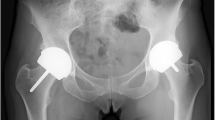Abstract
“My Hip Resurfacing (HR) has been recalled. What will happen to me?” This is the question of every patient who underwent an implant recall, a highly stressful event for both patients and physicians. Triggered by a 11.64% failure rate at 7 years, a recall process started for Adept HR with head diameter less than 48 mm. We report our experience in the recall process of 40 patients with the above-mentioned components. One patient underwent revision surgery due to an adverse reaction to metal debris at 5-year follow-up. None of the patients were scheduled for revision, with an estimated survival rate of 97.6% at 7 years. Implants were well positioned with an average acetabular inclination angle of 37°. Cobalt and chromium blood levels were below the safety threshold of clinical relevance. Functional scores were excellent. In the case of a well-positioned device with normal ion levels, a good performance of the implant is generally observed. Even if we experienced a very low revision rate, this may certainly get worse over time since not all possible failures are predictable, thus requiring a careful periodic follow-up.


Similar content being viewed by others
References
Amstutz HC, Ball ST, Le Duff MJ et al (2007) Resurfacing THA for patients younger than 50 year: results of 2- to 9-year followup. Clin Orthop Relat Res 460:159–164
Su EP, Sheehan M, Su SL (2010) Comparison of bone removed during total hip arthroplasty with a resurfacing or conventional femoral component: a cadaveric study. J Arthroplasty 25(2):325–329
Bunn A, Colwell CW Jr, D’Lima DD (2014) Effect of head diameter on passive and active dynamic hip dislocation. J Orthop Res 32(11):1525–1531
Willis-Owen CA, Atkinson HD, Oakeshott RD (2011) Bone mineral density in the femoral neck increases after hip resurfacing: a cohort with five-year follow-up. Int Orthop 35(9):1303–1307
Pollard TC, Baker RP, Eastaugh-Waring SJ et al (2006) Treatment of the young active patient with osteoarthritis of the hip. A five- to seven-year comparison of hybrid total hip arthroplasty and metal-on-metal resurfacing. J Bone Joint Surg Br 88(5):592–600
12th Report. National Joint Registry for England, Wales and Northern Ireland [Internet]. 2015. http://www.njrcentre.org.uk
Annual Report. Australian Orthopaedic Association National Joint Replacement Registry. [Internet]. 2015. http://www.aoa.org.au
Kwon YM, Glyn-Jones S, Simpson DJ et al (2010) Analysis of wear of retrieved metal-on-metal hip resurfacing implants revised due to pseudotumours. J Bone Joint Surg Br 92(3):356–361
Langton DJ, Joyce TJ, Jameson SS et al (2011) Adverse reaction to metal debris following hip resurfacing: the influence of component type, orientation and volumetric wear. J Bone Joint Surg Br 93(2):164–171
Pandit H, Glyn-Jones S, McLardy-Smith P et al (2008) Pseudotumours associated with metal-on-metal hip resurfacings. J Bone Joint Surg Br 90(7):847–851
Daniel J, Pradhan C, Ziaee H et al (2014) Results of Birmingham hip resurfacing at 12 to 15 years: a single-surgeon series. Bone Joint J 96-B(10):1298–1306
Treacy RB, McBryde CW, Shears E et al (2011) Birmingham hip resurfacing: a minimum follow-up of ten years. J Bone Joint Surg Br 93(1):27–33
Matharu GS, McBryde CW, Pynsent WB et al (2013) The outcome of the Birmingham Hip Resurfacing in patients aged <50 years up to 14 years post-operatively. Bone Joint J 95-B(9):1172–1177
Murray DW, Grammatopoulos G, Pandit H et al (2012) The ten-year survival of the Birmingham hip resurfacing: an independent series. J Bone Joint Surg Br 94(9):1180–1186
Beaule PE, Dorey FJ, Le Duff MJ et al (2004) Risk factors affecting outcome of metal-on-metal surface arthroplasty of the hip. Clin Orthop Relat Res 418:87–93
Hing CB, Young DA, Dalziel RE et al (2007) Narrowing of the neck in resurfacing arthroplasty of the hip: a radiological study. J Bone Joint Surg Br 89(8):1019–1024
Madanat R, Hussey DK, Donahue GS et al (2016) Early lessons from a worldwide, multicenter, followup study of the recalled articular surface replacement hip system. Clin Orthop Relat Res 474(1):166–174
Pahuta M, Smolders JM, van Susante JL et al (2016) Blood metal ion levels are not a useful test for adverse reactions to metal debris: a systematic review and meta-analysis. Bone Joint Res 5(9):379–386
Cadossi M, Tedesco G, Sambri A et al (2015) Hip resurfacing Implants. Orthopedics 38(8):504–509
Daniel J, Ziaee H, Salama A et al (2006) The effect of the diameter of metal-on-metal bearings on systemic exposure to cobalt and chromium. J Bone Joint Surg Br 88(4):443–448
Brooks PJ (2016) Hip resurfacing: a large, US single-surgeon series. Bone Joint J 98-B(1 Suppl A):10–13
Lewinnek GE, Lewis JL, Tarr R et al (1978) Dislocations after total hip-replacement arthroplasties. J Bone Joint Surg Am 60(2):217–220
Kim PR, Beaule PE, Dunbar M et al (2011) Cobalt and chromium levels in blood and urine following hip resurfacing arthroplasty with the conserve plus implant. J Bone Joint Surg Am 93(Suppl 2):107–117
McMinn DJ (2003) Development of metal/metal hip resurfacing. Hip Int 13(1):41–53
Author information
Authors and Affiliations
Corresponding author
Ethics declarations
Conflict of interest
The authors declare that they have no conflict of interest.
Rights and permissions
About this article
Cite this article
Cadossi, M., Terrando, S., Sambri, A. et al. What should I expect from my recalled Adept Hip Resurfacing?. Musculoskelet Surg 101, 249–254 (2017). https://doi.org/10.1007/s12306-017-0476-x
Received:
Accepted:
Published:
Issue Date:
DOI: https://doi.org/10.1007/s12306-017-0476-x




